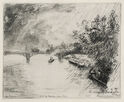
19th, 20th & 21st Century Fine Prints
707-546-7352 · fax 707-546-7924 · web: www.annexgalleries.com · email: artannex@aol.com
Felix Bracquemond Biography
Felix Bracquemond
French
1833–1914
Biography
Printmaker, painter, and ceramicist Felix Bracquemond was born in Paris, France on May 22, 1833. He trained as a commerical lithographer in his teens before studying under painter Joseph Guichard. His painting of his grandmother, created at age nineteen, gained critical acclaim at the Paris Salon. While undergoing his studies in painting he taught himself how to engrave using the manual Encycloépdie written by Diderot and d'Alembert. By the 1850s, intaglio printmaking became his preferred medium and he remained a consumate self-taught printmaker, going on to revive printmaking in France.
Like many printmakers of the time, Bracquemond made a name for himself through his renditions of paintings by established artists, but he was also one of the first to create portfolios of his own imagery, collaborating with the publisher Auguste Poulet-Malassis. He would become known for the tonality he achieved on the plate, and the detail he captured in his landscapes, portraits, and scenes of contemporary city life. |
In 1862 he became a member of publisher Alfred Cadart's Société des Aquafortistes with the help of his friend, the artist Auguste Delâtre. Bracquemond himself encouraged his painter friend Jean-Baptiste Corot, Jean-François Millet, Édouard Manet, Edgar Degas, and Camille Pissarro to learn engravind and he was an integral mentor to Manet when he created "Olympia" and "L'Homme mort". In 1888 he he co-founded L'Estampe originale with Daniel Vierge and Tony Beltrand, and he participated in the major exhibitions throughout France.
In addition to etching, Bracquemond was a pioneer of color lithography, his compositions exhibiting a painterly quality that has not yet been sought by printmakers. His early discovery of Hokusai's wood-engraved Kachô-ga Manga - imagery depicting flowers, birds, insects, and crustaceans - continued to influence his style. This led to his interest in ceramics and decorative design, and he would be commissioned by earthenware merchant Eugene Rousseau to create a full service set. Its popularity would help foster the Japonisme movement in France.
Bracquemond married the artist Marie Anne Quivoron in 1869. A student of Ingres, Marie's success as a painter would prove to be a source of contention for Felix and he frequently discouraged her from showing her work. Despite this, she developed into a noted Impressionist on par with Berthe Morrisot and Mary Cassatt later in life. Though they remained at odds throughout their lives, the Bracquemonds worked together as ceramicists.
By the end of his life, Felix Bracquemond was considered one of the most influential artists of his time. He died on October 29, 1914, in Sevres, France.

